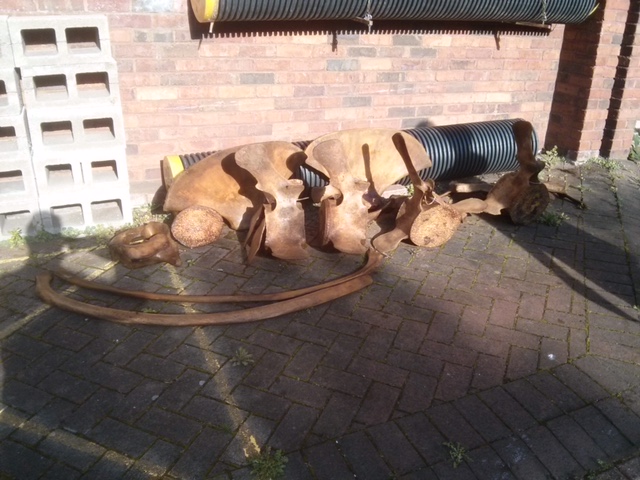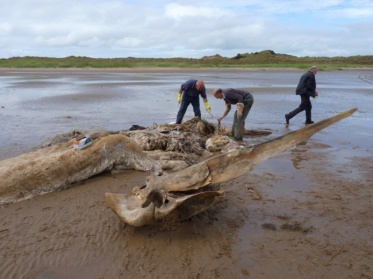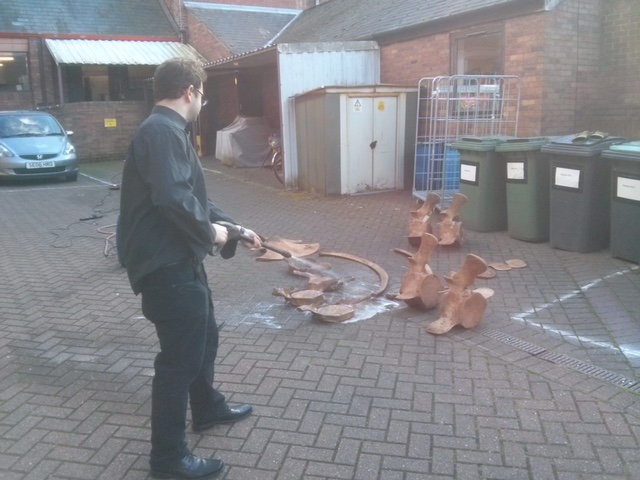Blog Archives
Tullie Whale Tale Part I
Follow the story of our whale skeleton here: discover how he or she was found, her journey to the Museum, and follow the, as yet to be written, story of how she will settle in.
One of the things that I love about my job is that I’m lucky enough to go home and say things like “I cleaned a whale today!” Recently, Stephen Hewitt (previous Natural Sciences Curator) and myself created a buzz in the Museum, as we unloaded our newest addition to the ‘family’: a whale skeleton.
The whale was found washed up on Drigg Beach, Ravenglass (Cumbria) in February 2014, grabbing local headlines (e.g. News and Star[1]). The discovery was made by Edna Kennedy, from Eskdale who is reported to have saying, “at first we weren’t sure what it was but, as we got closer, we could see it was huge“.
Although initially identified as a fin whale by the Marine Conservation Society, Dr Emily Baxter of the Cumbria Wildlife Trust re-identified the specimen as a sei (pronounced “say” or “sigh”) whale (Balaenoptera borealis) (which has to be confirmed by the Museum). This strange name (sei) comes from the Norwegian word for Pollock, which it is often found with in Norway [2]
So how did this whale end up on one of our beaches?
This young individual (we can tell it is a sub-adult from the degree of fusion in the bones) may have become separated from its small pod (sei often travel in groups of up to 5 individuals) as it was migrating from its winter grounds further south (north-west Africa, Spain and Portugal) to its northern summering grounds (typically off Shetland, Faroes, Norway and Svalbard)[3].
What we do know is that this endangered species[4] is a very rare Cumbrian visitor —most records from the British Isles come from deeper waters from their northern summer grounds.
To give you an idea of what this fantastic specimen looked like in its former life: sei can reach up to 15 m in length3 (this juvenile would have been a few metres shorter). It is a baleen whale with long comb-like plates, instead of teeth, hanging from the upper jaws; an ingenious adaptation for capturing krill and other plankton through straining vast quantities of water in a single ‘gulp’. However, unlike other baleen whales, this blue-grey species has an erect, dolphin-like dorsal fin, and a distinctive single ridge along the snout (distinguishing it from the similar Bryde’s whale [5]).
So back to the story: it took several months of negotiation before a team of four, including Steve Hewitt, could recover the decaying gargantuan carcass (with the permission from Muncaster Estate, Natural England and Copeland District Council). By August, 2014 the carcass had decayed considerably. The once familiar outline of the whale was now gone and although one half of the lower jaw had been removed, the now exposed skeleton remained largely intact and plans were made to rapidly recover the bones. Almost disastrously, a storm struck in the intervening days and the team arrived to find the whale – gone! However searching further around the point eventually led to a trail of detached vertebrae and eventually, to the main part of the skeleton which had been rolled along the beach by the sea. This meant that the front part of the skull had become detached and only half of it was found. However, most of the remaining skeleton apart from a few vertebrae may be that other people picked up some of the missing bones and if so the Museum would be very pleased to hear from them.
So what next? Now we needed to clean the bones and remove all the grease and remaining fragments of tissue, so that the specimen could (hygienically) enter our Museum collection. So how did we do this? Perhaps some kind of immersion in laboratory acid? No, we did this naturally! That is we buried the bones in raised beds of sand, to let natural bacteria, insects and other invertebrates, complete the decomposition process and expose our ‘prize’ (albeit, with the help of some manure to speed things along).
Meanwhile, at the Museum, all kinds of rumours and intrigue were building in the run-up to the long-awaited whale. “Have you heard about the whale?” often popped up into many conversations. Indeed, I often encounter many exciting things in the depths of collection areas, but I was particularly excited to actually see the whale.
And so on Thursday, October 8 2015, Stephen Hewitt drove up with the first instalment of the whale skeleton in the back of his car (the rest, still buried, needs a while longer for the slow cleaning process and will require a considerably bigger vehicle to transport it!). Being a curator desensitises you somewhat from the fact that each bone was coated with a thick layer of muck. As we began to clean the bones with a high-pressure water jet, I realised that my choice of clothes for that day was quite poor. But although the jet-stream had to be powerful enough to displace the envelope of ‘muck’ encasing each specimen, it did not harm the bones- in fact we need to clean them again. It’s a painstaking job but (apart from being actually quite fun!) is necessary before they can properly enter the collection.
So I’m afraid now you will have to eagerly await for next instalment, in several months, when we can recover the rest of the skeleton.
So stay tuned for my next whale tale post… But in the meantime please feel free to leave a comment…
By Simon Jackson
Curator of Natural Sciences
[1] News and Star, Thursday, 20 February, 2014, updated Friday, 21 February, 2014
[2] Office of Protected Resources: NOAA Fisheries http://www.nmfs.noaa.gov/pr/species/mammals/cetaceans/seiwhale.htm
[3] Atlas of Cetacean Distribution in North-West European Waters. Compiled and edited by Reid, J B, Evans, P G H, Northridge, S P (Joint Nature Conservation Committee 2003)
[4] The IUCN Red List of Threatened Species: Balaenoptera borealis http://www.iucnredlist.org/details/2475/0 (as accessed 19 October, 2015)
[5] Encyclopaedia of Life http://eol.org/pages/328572/overview


